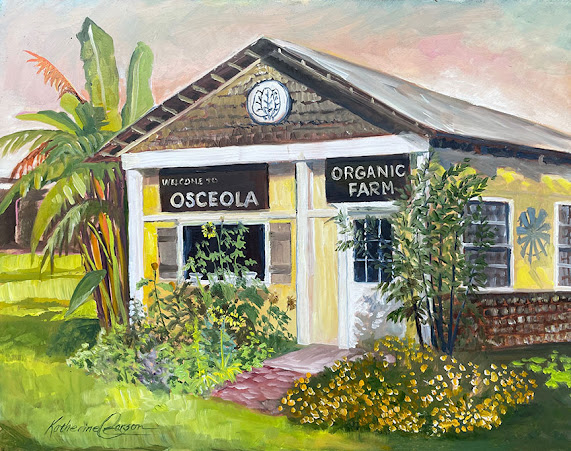The Saga of the Ampersand Claybord painting
If you're a painter you've probably tried a clayboard at some time or another. I did it yesterday. They were on sale...so I decided to try them out. I've heard people rave about the amount of detail you can get with them. Since I was painting an organic farm with lots of interesting plantings...I decided now was the time to give it a try.
It was the most frustrating material I've ever worked with! The paint slid around on the surface not finding anything to cling to. Lines were impossible and detail was even more impossible. Also the adjacent colors were picking up each other and blending into a terrible muddy mess. After two hours of struggling...I took a turpentine rag and wiped the whole thing out! The last time I wiped out a painting was about 15 years ago. I was so downcast. After sitting there for a few minutes in front of the beautiful little building I was trying to paint...a little voice inside my head said: "Other people use this board and come out with great paintings...so it's not the board...its you."
I took a deep breath and started again. This time I started with very diluted painting. I put the base down with a sepia tone mixed water thin with turpentine. So far so good...the paint was sticking and actually drying quickly on the board. I had the drawing done in about 15 minutes. Now the color...learning from my mistakes...I did not use the oil medium. I mixed the colors I wanted with turpentine- or just put them down straight without any medium. They stuck! Not only did they stick...they retained their brilliance and texture. Without the oil medium the adjacent colors also did not contaminate each other.
By this time the sun had disappeared and it was coming on lunch time...so I quit with the intention of continuing on to see what I could make of this failed painting. Back in the studio a few hours later...I continued painting completely without the use of the oil medium. Now if you are an oil painter...you'll know how strange a thing this is. When you start a traditional oil painting you wipe down the canvas with oil. So working dry is completely against the rules. But using oil on this board didn't work at all. The drier I kept it...the more detail I was able to achieve. After only two hours in the studio the painting was completed. It finally matched what I had seen early in the morning after arriving at the site. What a thrill it was to see a destroyed painting come back to life!
Words of wisdom to anyone with a failed painting: remember that someone else has gone through it before. Don't give up. Get stubborn. Move through it and be willing to change what you think you know.




Comments
Post a Comment